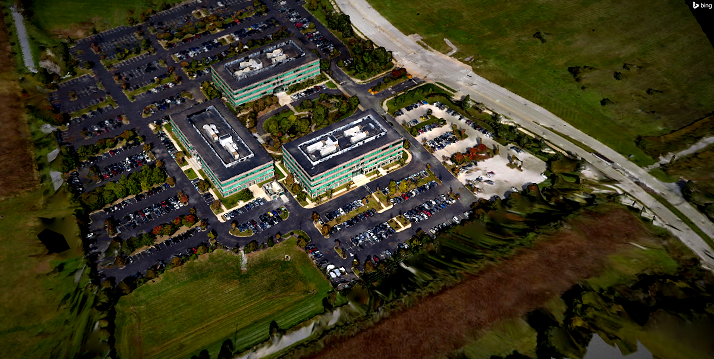3D Tiles Overview
3D Tiles is an open standard designed to describe and organize massive geospatial datasets in a manner efficient for both 3D rendering and analytical querying. Pioneered by Cesium, this standard is now widely used in the geospatial community and is an Open Geospatial Consortium community standard. A 3D tileset is an instance of geospatial data that adheres to the 3D Tiles specification. 3D tilesets are used to represent massive point cloud data, dense meshes from a photogrammetry capture, massive cities defined in CityGML/OpenStreetmap, high-fidelity CAD models, and more.
You can import 3D tilesets from files residing on your local machine and network and also from servers registered through
Your Ansys Systems Tool Kit® (STK®) digital mission engineering software installation includes a sample 3D tileset of a photogrammetry model of the AGI Headquarters located in Exton, Pennsylvania. This 3D tileset is located in your STK software install folder and is available for offline use.

Photogrammetry of AGI Headquarters captured into a 3D tileset
You can identify a 3D tileset by a root metadata JSON file that describes how it is organized. Typically, this file is named tileset.json, but this naming convention is not mandated by the 3D Tiles specification. When adding a tileset that is stored in your local file system, select this root JSON file. The STK software will use the directory name that contains this JSON file as the tileset name. A tileset JSON file may organize the dataset by referencing other child tileset JSON files, resulting in many JSON files to choose from. While it is valid to include a subset of the complete tileset by including a child JSON file, only one JSON file will be the root metadata file that describes the complete dataset.
The STK software supports 3D Tiles version 1.0 and the optional 3DTILES_content_gltf extension, which you can use for both visualization and some analytical capabilities for mesh geometries.
Using a 3D tileset for visualization and analysis
You can import 3D tilesets to your scenario for both visualization and analysis purposes. In the STK application, you can distinguish between using a 3D tileset for visualization in the 3D Graphics window and using it for analysis, meaning configuring the tileset for analytical computations.
Add 3D tilsets for visualization using Globe Manager. Refer to the Globe Manager Hierarchy Tab page for more information.
You can register a 3D tileset for analysis purposes in two ways:
- Add it in the 3D Tiles page of a scenario object's Basic Properties.
- Click on the Add for Analysis prompt when you when you add a tileset for visualization in Globe Manager.
Using a 3D tileset as an Access constraint
You can enable a 3D Tiles Mask constraint for analysis for any Vehicle, Facility, Place, or Target object on their Constraints - Active properties page using a 3D tileset registered for analysis purposes. If you enable the 3D Tiles Mask constraint on an object participating in Access, the constraint will evaluate 3D tileset geometry for any visibility occlusion across the access interval. If there is a time span in which the geometry belonging to an analytical 3D tileset is obstructing the line of sight between two objects, then access will not be available during that span.
Adding a 3D tileset hosted in Geospatial Content Server
You can use GCS to host 3D tilesets along with terrain, imagery, and other heterogeneous 3D data. You can create a connection to GCS window in the
The public GCS server has been deactivated. If you have a local GCS server, it will still work.
Adding a 3D tileset hosted in Cesium ion
Cesium ion is a cloud-based platform for creating and hosting 3D tilesets that can be used in both Cesium applications and the STK application. With a Cesium ion account, you can explore the catalog of curated 3D tilesets in the Cesium ion Asset Depot and upload both source models and point clouds to construct and host custom datasets in Cesium ion's My Assets page.
An access token for the Cesium ion REST API is required to access curated tilesets, share tilesets with others, and import tilesets hosted in Cesium ion into the STK application. You can configure Cesium ion access tokens in the Cesium ion Preferences window of the
Adding the Google Maps 3D tileset
The Google Maps 3D tileset, known as Photorealistic 3D Tiles, is served through the Map Tiles API and hosted on the Google Cloud Platform. It enables visualization of global terrain and more than 2,500 cities across the globe, all defined within a single tileset.
You must provide the STK application with an API key that is configured with permissions to access the Maps Tiles API to include this tileset in your scenario. You can create a connection to the Google Maps Map Tiles API in the Google Maps Preferences window of the
AGI recommends that you replace all existing imagery and terrain tilesets listed in Globe Manager with this single, high-fidelity tileset for visualization purposes. Globe Manager will prompt you to automatically perform this optimization for convenience upon adding the tileset.
In accordance with the Google Maps Platform terms of service and Map Tile API policies, the Google Maps 3D tileset is not available for analysis purposes.
Supported versions and extensions
The STK software supports 3DTiles 1.0, as well as a core subset of 3DTiles v1.1. The following supported features extensions defined for 3DTiles v1.0 are also supported for tilesets using v1.1 of the 3DTiles specification: